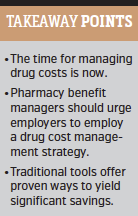Cost Management Approaches for Expensive Drugs
Addressing rising pharmaceutical costs is a top challenge for today’s managed care executives. In an attempt to exert some control, payers may be tempted to deny coverage for pricey specialty drugs altogether. 
That route, however, is not the way to go, Steve Johnson, PharmD, BCPS, senior director, health outcomes, Prime Therapeutics, told attendees at the PBMI Drug Benefit Conference.
Dr Johnson has a better strategy: manage costs while getting employees the medications they need.
“The key, in my mind, isn’t about helping employers say ‘no’ to some new drug that has captured headlines,” Dr Johnson said. “It is about applying different tools that help employers say ‘yes’ to the right drug, for the right patient, delivered through the right channel at the very best possible price.”
Time to Revisit Drug Benefit Management
Traditional pharmacy benefit management tools offer proven ways to yield significant savings. Yet too many employer groups are reluctant to use them, Dr Johnson said, out of fear of inconveniencing their employees combined with failure to grasp just how much money drug cost management tools could save them.
“Too often, employers consider the cost of the pharmacy benefit too small to offer meaningful savings,” he said. “But for many employers, retail prescription drugs account for 20% to 25% of their health care costs. Factor in drugs on the medical side, and prescription medicine is on par with the cost of inpatient hospital care.”
With the trend toward more expensive drugs, however, Dr Johnson predicts a shift in employers’ attitudes toward traditional medication cost management.
“I understand that benefit changes can generate negative reactions from employees. And employers often feel the pushback is not worth the savings. But the headline-grabbing cost of specialty drugs, and even many brand and generic drugs, that we have seen over the past couple of years is compelling employers to revisit that attitude,” he said.
Strategies for Cost Savings
Pharmacy benefit managers working for employers not taking advantage of traditional drug cost management tools should urge them to consider several possible strategies, Dr Johnson said.
• Utilization management: Use-of-management programs ensures employees get clinically appropriate and cost-effective medications when they need them. Tools include prior authorization to ensure appropriate indications, step therapy to require generics before brands, and quantity limits to prevent stockpiling or sharing of medications.
• Preferred drug management: Both the pharmacy and medical benefit can establish preferred medications as well as formulary exclusions to drive patients to cost-effective drugs. Design out-of-pocket costs to encourage use of preferred medications but not to limit adherence. Financial assistance can also be offered for preferred medications.
• Contracting management: Negotiate aggressive rebates, and use medical-side fee schedules to encourage providers to distribute the most cost-effective medications.
• Care/case management: Provide patient counseling to ensure safe and effective use of medications, use of preferred health care providers, and coordinated care.
• Channel management: Establish incentives for 90-day supplies with higher discounts, either through mail-order or retail networks. Limiting the number of retail pharmacies in the network is another tool that is growing in popularity.
“Virtually everyone who receives Medicare uses a narrow network of pharmacies,” pointed out Dr Johnson. “Many employers have resisted this step because of the perceived inconvenience. With over 65,000 pharmacies in the United States, maybe people would be willing to narrow that choice if it helped control health care costs.”
On the medical side, Dr Johnson said the site of care (home infusion, physician office, or outpatient facility) should be optimized since costs can vary by thousands of dollars based on setting alone.
Millions on the Line
 They may not be flashy, but these tried-and-true methods can make a big difference to payers and deserve attention. “Sometimes people get so consumed with how rapidly the industry is changing that they overlook the basics. Pharmacy benefits managers need to lead the way in innovation, including performance-based contracting, disease-specific accountability models, predictive analytics, and things of that nature,” said Dr Johnson.
They may not be flashy, but these tried-and-true methods can make a big difference to payers and deserve attention. “Sometimes people get so consumed with how rapidly the industry is changing that they overlook the basics. Pharmacy benefits managers need to lead the way in innovation, including performance-based contracting, disease-specific accountability models, predictive analytics, and things of that nature,” said Dr Johnson.
“But payers, particularly employer groups, need to look at all the traditional tools available to them and start saying ‘yes’ to those because they have been proven to yield savings. And even small savings, compounded over time, add up to millions of dollars.”
The speaker shared with the audience “A Tale of Two Employers.” The employer groups were similar, he explained, except for one big difference: Employer A neglected to institute a complete drug cost management strategy, while Employer B did. The result? Nearly $34 million in excess drug costs shouldered by Employer A.
Stakes Are Higher
The moral of the story is clear—the time for managing drug costs is now.
“Prescription medicine is going to become a larger and larger factor in people’s health and in health care spending. There are a lot of new drugs in the pipeline. Some of them may be miracles for people suffering from various types of cancer, multiple sclerosis, and autoimmune diseases. Other drugs may offer marginal, if any, additional benefits,” he said.
“So as the industry changes, the challenge remains the same: How do we ensure that people who need these medicines have access to them while keeping the cost of coverage affordable? The stakes are getting higher.”
As Dr Johnson reminded the audience, benefit decisions affect the health and well-being of real individuals.
Rather than issuing a blanket refusal to employees, even those who stand to benefit from a new specialty drug, payers will do better using established tools to ensure their workers are healthy and happy, and that their cost of care is affordable.—Jolynn Tumolo













